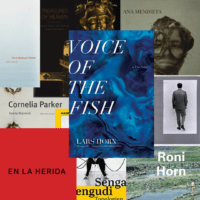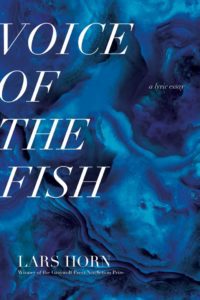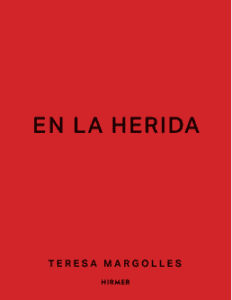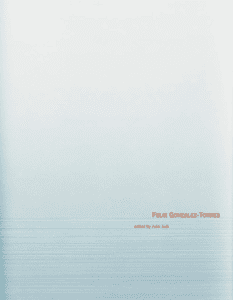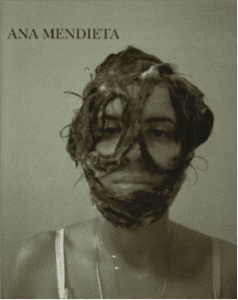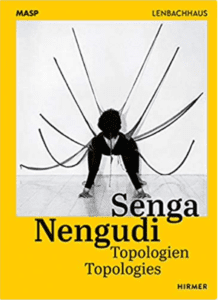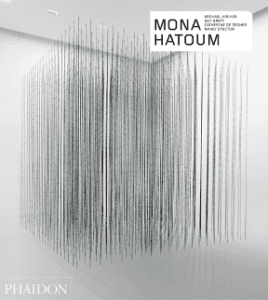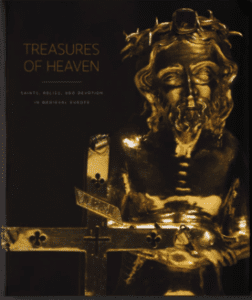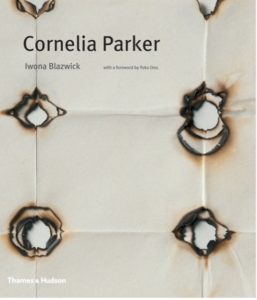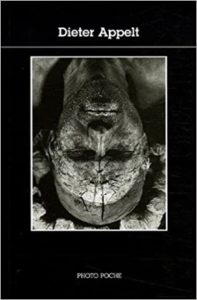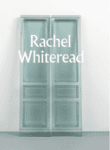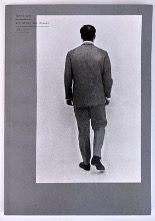I know that it’s my job to get excited about books, but sometimes I get really excited. Case in point: Lars Horn’s Voice of the Fish, which I had been eagerly awaiting since Graywolf announced its 2020 Nonfiction prizewinner. The book is absolutely worth the anticipation. Keep scrolling for their rich and generous reading list. – Eds.
***
In 1964, Romanian artist Ana Lupaș began her large-scale collaborative sculpture project The Solemn Process—a work intended to continue indefinitely as an annual rite of harvest. Working alongside rural inhabitants of Transylvania, Lupaș constructed wreaths and other abstract sculptural forms from wheat. The wheat objects were then displayed in the villagers’ farmyards. This process continued into the mid-seventies, but came to a halt faced with the socioeconomic upheavals sweeping Romania at the time. As the sculptures decayed, Lupaș unsuccessfully attempted to repair them. In the eighties, she undertook a body of drawings, again seeking to prolong the work in time, space, and medial breadth. Finding this insufficient, Lupaș hit upon an alternative solution. From 1985-2008, Lupaș commissioned the skills of local metalworkers who welded the moulding structures into what Lupaș refers to as “tins.” But far from simple cylinders, the metal casings echo the wheat sculptures’ varying dimensions—great steel bodies, circular, domed, segmented. The metal patchwork strangely reminiscent of bandage. The entire work—five decades of process, of trial and salvage, of idea ricocheting into practice, now entombed, brought to heavy rest in an upper room of London’s Tate Modern gallery.
Whenever I’m in London, I visit Tate Modern, and, each time, I stand with The Solemn Process. Even writing from Miami Beach—some four-and-a-half thousand miles from London, and another thousand from Romania—I scroll through my phone’s photographs of my last visit, the visit before last. It seems, aptly, that I make a yearly pilgrimage. So continues the harvest.
There is something reminiscent of ancient burials in The Solemn Process. A sanctity normally reserved for rites of clergy. Extreme unction. Almost canopic. Lupaș encased the sculptures so they might endure—what else but an embalming? Final rite and preparation for unknowable afterlife. But this solemn process, where exactly does it occur? In the design and construction? In the maintenance and preservation? Or all of these, and the final reverence: the pilgrimage to see, bear witness. When one comes to look at another’s work, at thought and gesture, at movement rendered image, object, texture. When life acknowledges life.
The world has never felt particularly worded to me. Materiality, colour, sensuality—these vocabularies come more easily. So, given those rare expanses of time when I can sit, hours dimming into night, when I can’t make a journey in person, I choose familiar touchstone, rough compass of physicality, I open a book and choose not to read, but to look.
En la Herida by Teresa Margolles
In 2012, walking through the Hayward Gallery, I stepped through a doorway of industrial plastic sheeting. A humidifier whirred within small, windowless room. I waited, shivered. My lips, forearms, my palms—all vaguely damp. When I stepped back through the plastic and read the accompanying curatorial note, I learnt that the humidifier had been filled with water used to wash the bodies of murder victims in Mexico City. This was my first introduction to the work of Teresa Margolles. Born in 1963 in Culiacán, Mexico, Margolles addresses issues of social injustice, violence, and migration. She works frequently with morgues, incorporating disinfected run-off water and blood from victims of homicide—casualties Margolles fears might otherwise go unheard, un-mourned. In En el Aire (2003), Margolles uses disinfected water from washing the dead to power bubble machines, filling galleries with ancient vanitas motif. a piece of attraction and repulsion, the work forces unwilling viewers—often white European, American, or Canadian—to face issues of violence in Mexico and beyond. La Gran América in Miami’s Perez Art Museum commemorates migrants who have attempted to cross the Mexican-American border with a wall display of 700 cobblestones fired from dirt and clay of either side of the Río Grande.
Margolles is an artist who inhabits my thinking. Ever since my first experience of her work, I have returned to her attempts to honour those lost—migrants, indigenous women, trans women, sex workers. Visceral, complex, ethically challenging, Margolles’ work is not something that can be entered without leaving one altered. Nor does it lead any kind of simple, questionless existence. I sometimes wonder whether I’d want the water that washed my loved ones pumped through galleries, breathed by unknown audience. I’m not sure there’s any clear resolution to Margolles’ work—its subject matter or the questions it raises—but it is most definitely a body—messy, intricate, artful, violent—that I revisited unfailingly.
Please note: Margolles’ work contains violent and graphic imagery and subject matter.
Félix González-Torres by Félix González-Torres and Ana Mendieta by Ana Mendieta
My mother taught me: When arriving somewhere new, visit the galleries and the cemeteries—you learn a lot from how a place treats its artists and its dead. Recently, my mother came to stay with me in Miami, during which we spent a morning in the De la Cruz private art collection. Disappearing behind a wall, my mother gasped. Moments earlier we had pocketed mint cough sweets from Félix González-Torres’ Untitled (Portrait of Dad) (1991)—a work of fluctuating dimensions, a 175-pound pile of mint candies that viewers can take at will—precarious balance between individual and collective interest, between robust and dwindling body. As we took the sweets—I can see mine now, cellophane-wrapped on the bookshelf—my mother described another of González-Torres’ portraits of his father, “González-Torres’ father sucked on cough drops as he died from throat cancer. In ‘Untitled’ (Throat), González-Torres arranged the cough drops on a white handkerchief.” My mother wrote extensively on González-Torres’ artworks for her PhD dissertation. I wasn’t sure what else could solicit equal awe.
Like González-Torres, Mendieta was born in Cuba and emigrated to the United States. Mendieta died at only thirty-six after falling thirty-three storeys from her New York apartment. Her husband, the sculptor Carl Andre, was investigated for, and acquitted of, her murder. In her performance work, documented in video and photographs at the De la Cruz Collection, Mendieta uses her own body either directly—lying in the landscape—or as spectral echo—her body a clay-stained trace, blazing red pigment. There is a grave-like quality to the work. A sense of the shroud, age-old burial rite. Perhaps it is their combination of art and the grave that makes Mendieta’s and González-Torres’ work so powerful, their elevation of artistic gesture to the sacred, an alignment in ritual time as well as in the fast pace of cultural moment.
Senga Nengudi: Topologien/ Senga Nengudi: Topologies by Senga Nengudi and Roni Horn by Louise Neri
Emerging from the radical Los Angeles artist movement of the fifties and sixties, Senga Nengudi has used soft structures—including the human body—as sculptural and performative medium to address questions of object materiality, time, race, and gender. In opposition to the era’s “dematerialisation” of the art object, Nengudi deployed soft, sac-like structures—rubber, weighted nylon stockings—often choreographing them to her own movements. Her acute sensibility to materials and their productive interrelation recurs throughout her works. Form, pace, colour, weight, fragility—Nengudi’s sculptures reconfigure these elements in such a way that makes me ask: How can essay achieve that same balance, that slip or drag, be heavy nylon or slumped plastic? How can material interactions inform the causality of written narrative?
In the 1970s, Nengudi began Water Compositions—a series of sculptures in which Nengudi filled large vinyl sacks with coloured fluids and composed them, one atop another, strung between points—each arrangement varies. They are beckoningly bright, neon-like. And there’s tension: the utter stasis of such fluid medium, the haunting thought—if they split? Looking at Nengudi’s sculptural responses to water fed my own, and, alongside the work of Roni Horn, proved a key source when writing Voice of the Fish.
Roni Horn’s Water Double (2017)—a series of hulking glass cylinders, all varying shades of blue, white, and black, rough-hewn, topped with immaculately polished oculus—makes use of glass’ imperceptible status as a liquid solid, which is to say a material whose atoms move so slowly as to not be perceived yet resist the stasis of a solid. Cumbersome, mercurial surface, Horn’s Water Doubles have haunted my thoughts since I stood next to a pink cuboid version in Tate Modern. Nengudi’s Water Compositions and Horn’s Water Double form an unexpected complement in their soft and hard sculptural response to liquid element. The fluid sacks, polished glass—both clean, precise, brightly dyed, so distinct from natural water and each other, yet both still, calm, oddly lake-like.
Mona Hatoum by Guy Brett, Michael Archer, and Nancy Spector
Born in Beirut to a Palestinian family who fled Haifa, Mona Hatoum found herself stranded in London in 1975. From The Light at the End (1981)—a luminous sculpture that beckons viewers across a dark room only for them to realise the work is a searing barrier of heat—to Corps étranger (1994) in which an endoscopic journey through the artist’s body is projected onto the floor, or Keffieh (1993-1999)—a Palestinian headscarf woven from cotton and human hair, the experience of exile informs Hatoum’s work, the domestic often turned sinister or violent, the personal—dislodged, uncomfortably public. Hatoum’s art possesses an urgency, a power. The artist’s career—marked by innovation and an impressive diversity of sculptural and installation formats.
Treasures of Heaven: Saints, Relics, and Devotion in Medieval Europe by Martina Bagnoli
In 2011, The British Museum curated an exhibition that assembled, for the first time, some of the world’s finest sacred objects of the Middle Ages. My father insisted we go—and I am still grateful. The exhibits were as beautiful as they were miraculous, even outlandish—blood-smattered linens, gilt hands, precious stones. I have kept the catalogue—a Bible of sorts in its own right—by my bedside ever since, and, like scripture, it has an ability to reach out, even in the longest nights, to connect—age-old, ritual, press of gold and frankincense.
Cornelia Parker by Iwona Blazwick and Cornelia Parker
In 1991, at the request of British artist Cornelia Parker, the British Army exploded a garden shed filled with objects collected over a three-month period. Iconic British suburbia—sharded, charred, hurtling outward, spades, buckets, gnomes and all. Using wire to suspend the salvaged wreckage, Parker reconstructed the shed—mid-explosion—in gallery setting: a cube of debris, lit by single bulb, rippling to air currents as visitors enter and leave. Across her career, Parker has steamrollered brass instruments and shot pearls through a suit. I’ve included her here, because her artwork, besides its intelligence and, let’s be frank, sheer guts at times, never fails to energise: someone out there is making a career from blowing up garden ornaments, from trundling heavy roller over trombones. Perhaps, it’s this dynamic mix in Parker’s work that draws me back—how it pulls theoretical punches whilst realising them in compelling formats, and how, just occasionally, it has me laugh. Parker’s work is generous in that sense—vivifying, alive.
Dieter Appelt by Dieter Appelt and Christian Bouqueret
When writing Voice of the Fish, I spent a lot of time with Actes Sud’s Photo Poche edition of Dieter Appelt’s work—a slim book almost entirely devoted to visual plates. If you’re looking for extensive background and critical reception, this isn’t the book to reach for, but, if, instead, you’re searching for strange visual journey—disjointed, dreamlike—this volume of Appelt’s photography is ideal. I am consistently impressed by the physicality of Appelt’s photographs—his body crouched, buried, strung up, bound in plaster-soaked bandage; each image—liminal space, beauty quietly echoing threat.
Rachel Whiteread by Rachel Whiteread, Ann Gallagher, and Molly Donovan and Invisible: Art About the Unseen 1957-2012 by Ralph Rugoff and Helen Luckett
Between the ages of twelve and thirteen, I had an art teacher who had us draw glassware. Each week, the class—ever more desperately—hoped for a different still life subject. But, without fail, the wine bottles, cut-glass tumblers, perfume bottles, phials, and marbles loomed—green, blue, gold-rimmed, the world refracted, glittering, stretched and contracted. Only the media changed—pen, pencil, charcoal, colour pencil, oil pastel. One time, in answer to our pleas of change, the tutor slid reflective objects—mirrors, chrome kettles, cutlery—amongst the glass. We soon begged to have those thrown out and, faced with this unwavering vision of the year to come—risen, shimmering, a last mirage unleashed from the once sands of this fired and styled glass—we relinquished, submitted. That year, the tutor spoke of positive and negative space, the tendency, when drawing, to prioritise the physical object and neglect the negative—the odd-shaped gaps, swirling air. He urged us to flip how we looked. To give nothingness a form, weight. No outlining, no bottle-versus-space. All of it instead collapsed into tonalities—foreground, midground, back. That year, forced to look, and look again, circle around ever more familiar objects until I could see to the side, above, in slivers—that year marked a turning point, not only in my approach to draughtsmanship, sculpture, or even the act of looking itself, but also in my approach to walking a body through a life. To attribute absence with import, particular tangibility. To see a word or act—long past, but not lost, still rippling, unknowingly remembered, carried in another’s chest. These wakes of ourselves—eddying.
From casting the cavity of a bathtub, hot water bottles, or bookshelves to filling the vacuous interior of an entire house with concrete, Rachel Whiteread has made a career of materialising negative space. A sculpture in ghosts. Her works are familiar, yet strange, offering inverted perspectives of objects intimately known—reminder to rinse tired eyes, see afresh.
The final book on this list is a catalogue from the 2012 Hayward Gallery’s exhibition Invisible: Art about the Unseen 1957-2012—a curation of artworks dealing in ephemeral, unseeable, or intangible gestures and materials. It was here that I first learnt of Song Dong keeping a diary in water written across stone slab. How he believed the stone grew heavier with each thought and emotion, each confession sunk into its surface. The catalogue is understandably less vibrant than some of the other books listed here, yet there’s an expanse to it, a certain contemplative quiet. And, perhaps, after all, it is this invisibility, this ephemerality, that hints at another dimension of art’s appeal—only not in the sense of immaterial art objects, but of our collective comings and goings, of our desire, in the end, to look.
To breathe with the past gesture of someone else, stand where others have and will take short rest. Sites of communion, minor, half-hearted devotion, something no longer seen, but felt.
***
